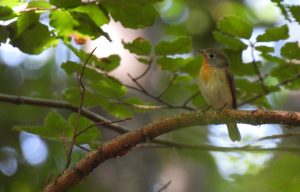
The ongoing EBCC project in Serbia is very successful
June 10, 2025 | alena.klvanova
Bird Protection and Study Society of Serbia was awarded in 2024 by EBCC for the project “Survey of poorly known forest birds and the first census of Collared Sand Martin (Riparia riparia) colonies in Serbia”.
Forest species in focus were easily overlooked and rare species whose poorly known breeding range edges are situated in mountainous forests of SE Europe (Willow Warbler, Eastern Bonelli’s Warbler, Wood Warbler, Collared Flycatcher, Red-breasted Flycatcher, Semi-collared Flycatcher).

Red-breasted Flycatcher Ficedula parva by Marko Ostojić
The project officially started in February 2025, when detailed planning was organised, including desktop analyses of the existing data for key project species and remaining gaps in breeding bird distribution-related data. Before starting fieldwork activities, a methodology manual and special form concerning key forest species were created for our members and volunteers.
The methodology for surveying forest species included 10-minute point counts of suitable forest types, where the presence/absence of species was checked using playback songs. Initial field surveys in 14 poorly known mountain regions of southern Serbia were expanded into over 25 areas visited during April, May and the beginning of June. During this period, over 250 point counts were taken, including descriptions of habitat, which will be used for further analyses. In addition to these surveys, observers noted all other bird species, which greatly helped our work for the first national Atlas of breeding birds in Serbia.
Overall results are still under analysis, and the last sites will be visited next week. Still, some great rarities for Serbia were discovered besides key forest species—Levant Sparrowhawk, Booted Eagle, Eastern Black-eared Wheatear, Zitting Cisticola, and Rock Sparrow. The greatest discovery was the presence of the Olive-tree Warbler near the border with Northern Macedonia, the first confirmed presence of the species in Serbia!
Also, with the first days of June, our preparations for the first census of Sand Martins have entered their final phase. A field work manual, methodology, and special form were developed, and a map with sites for visits was prepared so that the surveys could start in the following days. The best period for estimating birds in the colony and active holes is during the intensive feeding of fledglings. It is planned that over 100 sites will be visited by 10th July, when the end of this survey is planned. Overall project results are expected to be available by the end of October!
Marko Šćiban
Bird Protection and Study Society of Serbia
BirdLife in Serbia
